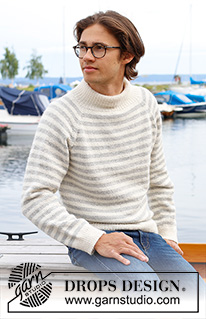Comments / Questions (3)
![]() Monika wrote:
Monika wrote:
Zastanawiam się, czy jeśli użyję Cotton Merino to robótka bardziej się rozciagnie niż w włóczek rekomendowanych?
12.09.2024 - 19:30DROPS Design answered:
Witaj Moniko, jak pracuję merynosem, zawsze robię sobie nieco większą próbkę, piorę ją i suszę. Wtedy mam pewność jak bardzo może rozciągnąć się robótka. Popatrz jeszcze TUTAJ - zasady prania i konserwacji. Pozdrawiamy!
13.09.2024 - 08:16
![]() MARIE-PAULE FINCK wrote:
MARIE-PAULE FINCK wrote:
Bonjour, Dans le paragraphe de l'empiecement, il est ecrit d'augmenter 18 fois mais il n'est pas précisé combien de mailles. Est-ce 8 mailles réparties sur tout le tour ? J'avoue ne pas bien comprendre. Merci pour votre aide que j'attends avec impatience. Cordialement
09.10.2023 - 15:01DROPS Design answered:
Bonjour Mme Finck, vous devez augmenter comme indiqué sous RAGLAN (autrement dit: 1 m de chaque côté de chaque marqueur soit 8 mailles par tour d'augmentations) 18 fois au total tous les 2 tours: tricotez 1 tour en augmentant comme indiqué ci-dessus, 1 tour sans augmenter et tricotez 18 fois ces 2 tours (36 tours au total). Bon tricot!
09.10.2023 - 16:25
![]() Anna wrote:
Anna wrote:
Prośba o korektę - w polskim opisie jest błąd: Increase like this 20-20-18-20-20-22 times on the body (10-10-9-10-10-11 times on the sleeves) Dodawać tak samo 15-17-14-17-16-19 razy na tyle i przodzie (5-7-5-7-6-8 razy na rękawach)
06.05.2023 - 22:31DROPS Design answered:
Dziękuję Anno, wzór został poprawiony i korekta dodana. Pozdrawiamy i dziękujemy za zainteresowanie naszymi wzorami!
07.05.2023 - 19:59
Latitude#latitudesweater |
|
 |
 |
Knitted sweater for men in DROPS Karisma or DROPS Puna. The piece is worked top down with double neck, raglan and stripes. Sizes S - XXXL.
DROPS 233-3 |
|
|
------------------------------------------------------- EXPLANATIONS FOR THE PATTERN: ------------------------------------------------------- RAGLAN: Increase 1 stitch on each side of 3 stitches (marker-stitch is the middle stitch) in each transition between body and sleeves by making 1 yarn over; the yarn over is knitted twisted on the next round to avoid a hole. The new stitches are worked in stockinette stitch. STRIPES: * 4 rounds with color off white, 4 rounds with color light pearl grey / light grey *, work from *-* to finished length. DECREASE TIP (for sleeves and sides of body): Decrease 1 stitch on either side of the marker thread as follows: Work until there are 3 stitches left before the marker thread, knit 2 together, knit 2 (marker thread sits between these 2 stitches), slip 1 stitch as if to knit, knit 1 and pass the slipped stitch over the knitted stitch (2 stitches decreased). ------------------------------------------------------- START THE PIECE HERE: ------------------------------------------------------- SWEATER – SHORT OVERVIEW OF THE PIECE: The double neck, yoke and body are worked in the round, on circular needle and top down. The sleeves are worked in the round with double pointed needles/short circular needle. DOUBLE NECK: Cast on 108-112-118-124-128-134 stitches with circular needle size 4 MM = US 6 and color off white DROPS Karisma or DROPS Puna. Change to circular needle size 3 MM = US 2.5. Work rib in the round (knit 1, purl 1) for 13 cm = 5⅛" (the neck will later be folded double). YOKE: Change to circular needle size 4 MM = US 6. Insert 4 markers as you work as follows: Knit 1 and insert marker-1 in this stitch, knit 27 (sleeve), knit 1 and insert marker-2 in this stitch, knit 25-27-30-33-35-38 (front piece), knit 1 and insert marker-3 in this stitch, knit 27 (sleeve), knit 1 and insert marker-4 in this stitch, knit 25-27-30-33-35-38 (back piece). Knit 1 round and increase 5-7-5-10-11-18 stitches evenly between markers 2 and 3 (30-34-35-43-46-56 stitches on the front piece) and between markers 4 and 1 (30-34-35-43-46-56 stitches on the back piece) = 118-126-128-144-150-170 stitches. Insert a marker thread between markers 4 and 1; the yoke is measured from here. Continue with stockinette stitch, increasing for RAGLAN and working STRIPES – read descriptions above. Increase every 2nd round 10-13-18-17-20-21 times = 198-230-272-280-310-338 stitches. REMEMBER THE KNITTING TENSION! Continue increases for the raglan, but every other increase is worked only on the body (4 stitches increased). i.e. increase on the body on every 2nd round and on the sleeves on every 4th round. Increase like this 20-20-18-20-20-22 times on the body (10-10-9-10- 10-11 times on the sleeves). You have now increased a total of 30-33-36-37-40-43 times on the body and 20-23-27-27-30-32 times on the sleeves. There are 90-100-107- 117-126-142 stitches for the body between markers 2 and 3 and between markers 4 and 1, and there are 67-73-81-81-87-91 stitches for sleeves between markers 1 and 2 and between markers 3 and 4. When all the increases are finished there are 318-350-380-400-430-470 stitches. Continue with stockinette stitch and stripes until the yoke measures 23-24-25-27-29-31 cm = 9"-9½"-9¾"-10⅝"-11⅜"-12¼" from the marker thread. Now divide for the body and sleeves as follows: Knit 1 (marker-stitch-1 belongs to the back piece), place the next 67-73-81-81-87-91 stitches on a thread for the sleeve, cast on 8-8-8-10-10-10 stitches under the sleeve, work 92-102-109-119-128-144 stitches (front piece), place the next 67-73-81-81-87-91 stitches on a thread for the sleeve, cast on 8-8-8-10-10-10 stitches under the sleeve, work the last 91-101-108-118-127-143 stitches (rest of back piece). Finish the body and sleeves separately. THE PIECE IS MEASURED FROM HERE. BODY: = 200-220-234-258-276-308 stitches. Insert 1 marker thread in the middle of the new stitches cast on in each side. Allow the marker thread to follow your work onwards; it is used when decreasing in the sides. Continue in the round with stockinette stitch and stripes. When the body measures 5 cm = 2" from the division, decrease 1 stitch on each side of both marker threads – read DECREASE TIP. Decrease like this every 5-6-6-6-6-6 cm = 2"-2⅜"-2⅜"-2⅜"-2⅜"-2⅜" a total of 4-4-4-4-4-3 times = 184-204-218-242-260-296 stitches. Continue working until the body measures 28-29-30-30-30-30 cm = 11"-11⅜"-11¾"-11¾"-11¾"-11¾" from the division – finish after at least 2 rounds with color off white (approx. 5 cm = 2" left to finished length); finish the body with color off white. Change to circular needle size 3 MM = US 2.5. Knit 1 round and increase 16-16-20-24-24-24 stitches evenly spaced = 200-220-238-266-284-320 stitches. Work rib (knit 1, purl 1) for 5 cm = 2". Bind off with knit over knit and purl over purl. The sweater measures approx. 62-64-66-68-70-72 cm = 24⅜"-25¼"-26"-26¾"-27½"-28⅜" from the shoulder down. SLEEVES: Place the 67-73-81-81-87-91 stitches from the thread on the one side of the piece on short circular needle/double pointed needles size 4 MM = US 6 and knit up 1 stitch in each of the new stitches cast on under the sleeve = 75-81-89-91-97-101 stitches. Insert a marker thread in the middle of the new stitches under the sleeve. Allow the thread to follow your work onwards; it will be used when decreasing under the sleeve. Continue in the round with stockinette stitch and stripes for 5 cm = 2". Now decrease 1 stitch on each side of the marker thread – remember DECREASE TIP. Decrease like this every 3½-3-2-2-1½-1½ cm = 1¼"-1⅛"-¾"-¾"-½"-½" a total of 10-12-15-15-16-17 times = 55-57-59-61-65-67 stitches. Continue working until the sleeve measures 41-41-40-38-37-35 cm = 16⅛"-16⅛"-15¾"-15"-14½"-13¾" from the division – finish after at least 2 rounds with color off white; finish the sleeve with color off white. Change to double pointed needles size 3 MM = US 2.5, knit 1 round and increase 5-7-5-7-7-5 stitches evenly spaced = 60-64-64-68-72-72 stitches. Work rib (knit 1, purl 1) for 5 cm = 2". Bind off with knit over knit and purl over purl. The sleeve measures approx. 46-46-45-43-42-40 cm = 18"-18"-17¾"-17"-16½"-15¾" from the division. Work the other sleeve in the same way. ASSEMBLY: Fold the neck double to the inside and sew down with a couple of stitches in each transition between body and sleeves. |
|

|
|
Have you finished this pattern?Tag your pictures with #dropspattern #latitudesweater or submit them to the #dropsfan gallery. Do you need help with this pattern?You'll find 30 tutorial videos, a Comments/Questions area and more by visiting the pattern on garnstudio.com. © 1982-2025 DROPS Design A/S. We reserve all rights. This document, including all its sub-sections, has copyrights. Read more about what you can do with our patterns at the bottom of each pattern on our site. |
|



































































Post a comment to pattern DROPS 233-3
We would love to hear what you have to say about this pattern!
If you want to leave a question, please make sure you select the correct category in the form below, to speed up the answering process. Required fields are marked *.